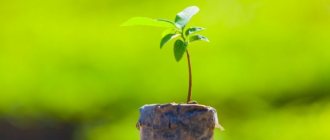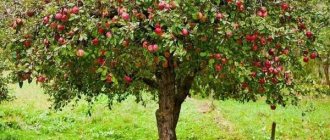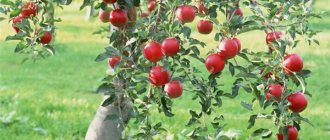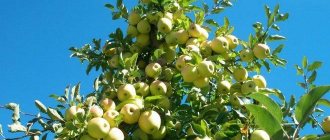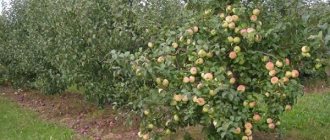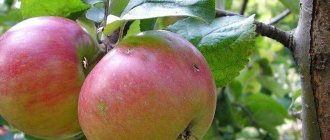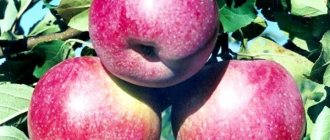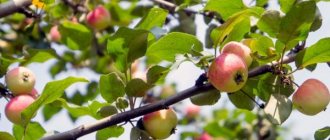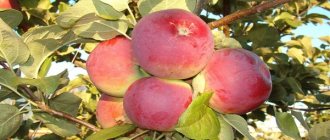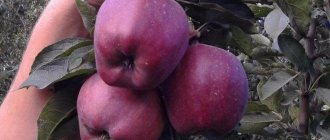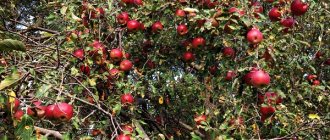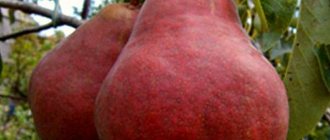History of the variety's creation
It is known that this variety was bred in 1928. At the moment, this is the standard for apple trees of medium and late ripening. The village of Mliev in Ukraine is considered the birthplace of Glory to the winners.
The authorship belongs to specialists from the experimental station of the famous fruit grower Lev Simirenko. The hybrid they obtained received high marks from professionals and amateurs, and since 1954 the plant has spread throughout the Soviet Union. At the moment, it is grown both in Russia and abroad.
Growing regions
Apple tree Glory to the winners: video about the variety
The ripening time for the harvest of fruits of this subspecies directly depends on the growing area. This period begins in the first ten days of August in the southern territories and in the second half of September in the northernmost regions of the country. But it is also worth knowing that when grown in the southernmost regions, fruits have a shorter shelf life than fruits grown in the northern territories.
The apple tree variety Glory to the Winners will also behave differently, depending on climatic conditions.
Due to its resistance to frost, this subspecies takes root well and adapts in almost every region of the former Union. That is why there is an opinion that in fact there is no area where the variety grows in a natural way.
This subspecies of apple tree is suitable for cultivation in both the south and northern territories, where the coolest climate prevails.
Although, depending on the growing region, the fertility of this tree also changes. While in Ukraine this apple tree is considered a late summer tree, in Central Russia it is an autumn tree. It should also be noted that in the Moscow region this plant bears fruit once every two seasons. Autumn subspecies in this region produce a harvest from September to November.
Cultivating these fruit trees in the North-West region is quite difficult, since low air temperatures prevail there in winter and a rather poor soil composition. The fertile layer is thin. Often these are peat bogs, sands and loams.
This apple crop grows well in Belarus, the North Caucasus and Ukraine.
Main characteristics
The tree usually grows up to 5 meters in height and has a spreading crown. But now some gardeners practice growing on dwarf and medium-sized rootstocks.
The first harvest can be obtained just a couple of years after planting, but it reaches stability approximately in the 5th year. The variety copes well with winter frosts, but is very afraid of drought, which forces it to get rid of fruits. In general, Glory to the Winners is characterized by apples falling off, so they are often picked unripe.
The crop can ripen both in summer and autumn - it all depends on the region where the crop grows. For example, residents of the southern regions can taste the fruits by the end of July, but closer to the north they should not wait for the harvest before September.
The branches are usually brown in color and located at an acute angle relative to the tree, although they grow wider as they mature. Fruit twigs can be seen on the middle branches.
The leaves are moderate in size, round or oval in shape, curved, without down. Sometimes they can be yellowish in color. The flowers are pink, and the closed buds have a rich red tint.
Description of the apple tree variety Glory to the winners
The variety compares favorably with others by its consistently high, regular fruiting, really good resistance to frost, unpretentiousness and endurance. It is also quite resistant to various apple fungal infections, is rarely affected by scab or powdery mildew, and produces beautiful, tasty fruits that are not afraid of transportation, with good commercial qualities. Even despite the tendency to excessively thicken the crown and have low tolerance to drought and heat, it is recommended for both large intensive commercial gardens and tiny home gardens.
Apples: what it looks like
Fruits can differ strikingly from each other not only in size, but also in shape, depending on many external indicators. The role played by soil, climate, weather, care, bait, watering and fertilizers. In most cases, the fruit is round, slightly conical or turnip-shaped, but can also be flattened. They are symmetrical, mostly one-dimensional, grow 120-190 grams in weight, so they can be classified as large or medium. The ribbing is mainly visible along one side seam. The skin is smooth, glossy, green or light green, becoming increasingly white-yellow as it ripens. The integumentary blush is red or carmine-red in color, blurred, streaked, spotted, covers approximately 85-95% of the surface, there is a slight waxy coating of a bluish tint. Subcutaneous dots are numerous, light, clearly visible, and often have a rusty area in the center. The composition is characterized by the following chemical indicators per 100 grams:
- P-active substances (catechins) – 112 milligrams.
- Ascorbic acid (vitamin C) – 8.7 milligrams.
- Total sugars (fructose) – 10.7%.
- Pectins (fiber) – 12.4%.
- Titratable acids – 0.82%.
The fruit pulp is fine-grained, medium density and very delicate texture. It is white, slightly yellowish or slightly creamy, juicy, sweet and sour, strongly aromatic. The taste is considered balanced and harmonious, dessert. The professional tasting assessment for the appearance and taste of the fruit is 4.4 and 4.6 points out of 5, respectively.
Apple tree Glory to the winner: characteristics
Crown and root system
Trees are considered tall because without formative pruning they can easily grow up to 6-7 meters or even more . The roots have a regular pyramidal shape at a young age, but over the years it turns into a highly rounded or highly oval shape. The lower skeletal branches grow at an acute angle to the central conductor, but the upper ones are already located almost at a straight line. The shoots are powerful, thick, geniculate, covered with brown, brown or red-brown smooth bark with barely any pubescence.
The leaves are densely located on the branches, medium in size, have a round-oval, slightly elongated shape, short-pointed, finely crenate, with a wavy, jagged edge, a beautiful light green shade with a barely noticeable yellowish tint. The root system is very powerful, branched, deeply deep, and uprooting such trees is not an easy, labor-intensive task.
Productivity and pollination
The productivity of Slava is considered high, on par with Antonovka. The trees are quite early in fruiting and there is no periodicity in fruiting. However, sometimes a tree can give itself a rest, but this happens very rarely, under the most unfavorable weather conditions, for example, after frostbite.
From one tree you can collect approximately 75-110 kilograms of aromatic fruit per season, but this is far from the limit. In 1997, a result of 306 kilograms was registered in the Tambov region. New dwarf and semi-dwarf varieties make it possible to obtain approximately 290-300 centners of apples per hectare.
Slava is considered a self-sterile (sterile to itself) variety. Therefore, if you do not plant it interspersed with other apple trees that are suitable for flowering periods, then no harvests will be obtained at all. There must be suitable varieties within 50-100 meters; it is good when there is an apiary nearby, and the trees themselves can be additionally sprayed with honey or sugar diluted with water. The bees and the wind will do the rest.
Winter hardiness and disease resistance
The apple tree is considered to be quite resistant to cold, which distinguishes it favorably from many high-yielding “relatives”. It can withstand frosts down to -25-30°C with virtually no harm, even if they last for at least 3-4 weeks in a row. It is not very afraid of sudden jumps and changes, unexpected thaws alternating with new frosts. However, you still cannot forget about shelter for the winter, otherwise the tree may refuse to bear fruit if it freezes. It doesn't hurt to protect it from drafts.
You will have to carefully monitor the health of the tree, although its resistance to scab and other fungal infections is average. When trees are affected during years of severe epiphytoty, both leaves and fruits suffer, and most likely you will lose the entire harvest. Therefore, it is imperative to immediately remove fallen leaves or fruits from the trunk area, not allow excessive moisture to develop, and regularly treat the trees with fungicides and insecticides against insects.
Rootstocks and subspecies
There are no subspecies of the variety, but it can be grown on a variety of rootstocks, which slightly affects the overall performance. When grown as seeds, the trees grow very tall, bear fruit well, are resistant to frost and scab, and bear medium-sized fruits. On dwarfs and semi-dwarfs (M-9 and M-106), the trunks are more compact and do not grow higher than 2.5-3 meters. Their fruits are somewhat larger, but winter hardiness and resistance to infections are noticeably reduced.
Description of fruits
Apples are round in shape, without ribbing. The skin is glossy; ripe fruits have a bluish coating. The size of the apples varies depending on the size of the tree and the yield. Usually the weight stays at 100-120 grams, but with good care it increases to 200.
The color of the fruit is greenish-yellow with a red tint. The brightness of the red color is related to the amount of sun the apple receives. Therefore, the closer the fruit is to the top of the crown, the redder it is. The lower specimens may have only one side painted.
The pulp is yellow, very juicy, and has a pronounced aroma. The taste is sweet and sour. A characteristic feature of the variety is that even overripe fruits remain juicy and tasty.
At the same time, the shelf life of the crop is short, so it is recommended to process it immediately after harvesting. Apples tolerate transportation well and do not lose their appearance. The fruits can also be collected unripe and stored in the cold for about 3-4 months.
Reader Questions
Where can I buy?
In addition to garden nurseries, spring or autumn fruit markets, seedlings can be purchased through online stores.
Apple tree seedlings in the nursery.
For example, a few:
What kind of processing is it suitable for?
Juicy, aromatic, tasty apples of this variety are well preserved. It is recommended to store them in cold cellars at 5-10 degrees. Celsius, placing in baskets or boxes.
very good for making jams, jams, juices, and compotes. They are also good to dry.
Pollinator trees
The variety Glory to the Winners is a cross-pollinated plant. Therefore, for a good harvest, it is necessary to place other types of apple trees nearby. The best options are:
- Melba;
- Antonovka;
- Borovinka;
- Priam;
- Vadimovka;
- James Grieve.
Melba
Antonovka
Borovinka
Diseases and pests
The apple tree is afraid of some diseases, and this is very important to consider before planting a tree. The main problems noted are:
- Powdery mildew occurs due to frequent fogs, large amounts of dew, and elevated temperatures. It looks like a coating on the leaves, which is initially white and erases without problems, and then turns brown. The disease weakens the apple tree, it stops growing and does not produce a harvest, the foliage turns yellow, after which it falls off before the permissible period. To cope with powdery mildew, you can use copper oxychloride, iron sulfate or boric acid. The crop is treated both before flowering and after harvesting the fruits.
- Scab is the most common disease. Shows itself in the form of black dots on leaves and fruits. The problem arises in hot, damp and acidic soil. The leaves fall and curl. Copper sulfate, Horus, Skor, Polychom products are used for processing. It is also advised to plant trees not too close to each other.
- Fruit rot can appear due to failure to maintain cleanliness under the tree - for example, if last year's fruits and foliage remain. To get rid of the problem, it is necessary to clean the area under the tree, and also spray not only the above-ground part, but also the soil. Bi-58 is used for prevention, and Fundazol is used for treatment.
- Milky shine. First, the disease attacks the leaves, and then the branches and wood. If the problem is ignored, you may lose the plant. It will take a very long time to get rid of it, and not only by spraying it, but also by treating the wounds on the tree with special glue.
Powdery mildew
Fruit rot
Scab
As for pests, they are the same as those that affect other apple trees: codling moth, aphids, and so on. You can fight them by the following means:
- When infested by aphids, mites and psyllids, a solution of karbofos effectively helps.
- To get rid of leaf rollers and apple moths, you can use a chlorophos solution.
- To remove apple moth, a solution of Zolon is recommended.
It is worth noting that treatment should not be carried out later than 40 days before harvesting.
Terms of flowering, fruiting and storage of apples
In spring, pinkish flowers appear on the tree, like cups, with a pleasant aroma. Fruiting of the apple tree variety Glory to the Winner at a young age is regular. With age it produces periodic harvests.
To regulate this process, it is recommended to grow fruit trees on fertile soil. In this way, annual fruiting can be guaranteed. When growing on poor soil, you should not expect a miracle - the yield will be low and periodic.
Depending on the zoning, fruit harvesting occurs at the end of August - end of September. When the variety is grown in the Oryol region, apples retain their properties and do not lose their attractiveness until December. In Kuban, the shelf life does not exceed 2 weeks.
Fruits should not be left on the tree until they are fully ripe. If the apples do not fall to the ground, they will become overripe. This is evidenced by the color of the pulp - it becomes dark. The litter is not stored for a long time, so you need to remove the fruits from the tree before they are fully ripe.
On a note! When there are strong winds, apples fall to the ground. To avoid crop loss, you should carefully monitor the weather forecast so as not to miss the moment of harvesting.
When storing fruits in the cellar, apples last 1.5 months. Can be stored in the refrigerator for up to 3.5 months. A remarkable feature of the variety is the ability of the fruit to ripen in a room where the temperature is maintained at +5ºC.
Advantages and disadvantages
The variety is characterized by the following positive features:
- With proper care, you can harvest a huge amount of crop, which is enough for both processing and sale.
- Fruiting is stable: the apple tree always produces a harvest, without taking “breaks” for several years.
- The variety tolerates wintering well; it practically does not freeze or die.
- The apples look very nice, the taste is bright and rich.
It is worth noting the disadvantages of the Glory to the Winners variety:
- The tree is afraid of dry periods, so in the southern regions you may encounter fruit shedding even before they ripen.
- The crown is very thick, which can affect the quality of apples. The plant puts all its strength into the crown, and the fruits will turn out small and tasteless. Therefore, it is necessary to thin out the crown at least once a season, which can be difficult for inexperienced gardeners.
- For a good harvest, pollinators must be planted next to the Glory of the winners. Some may find this inconvenient.
- Apples may fall off and therefore lose their presentation. It is very important to know the signs of fruit ripeness in order to harvest on time. Sometimes a special tool is required for removal.
Varieties of rootstocks
The variety Glory to the Winner can be grafted onto dwarf, semi-dwarf and medium-sized rootstocks.
Rootstocks for apple tree grafting are selected depending on:
- Zones where the apple tree will grow
- Irrigation possibilities,
- Depending on the type of planting.
In addition to pome rootstocks, which are characterized by good frost and drought resistance and resistance to viral diseases, clonal ones , i.e. vegetative rootstocks :
- M9 – dwarf rootstock;
- MM106 - semi-dwarf rootstock and others.
They have good compatibility with the variety that is grafted onto them.
It is important that such a rootstock has a restraining effect on the grafted variety and is characterized by good
rooting ability (the root system formed by the rootstock is branched, fibrous).
A grafted tree begins to bear fruit earlier than on rootstocks grown from seeds.
Thus, in the southern regions, on weak-growing vegetative rootstocks, apple trees begin to bear fruit in 4-5 years, in more northern regions - later.
In addition, the productivity of the variety becomes much higher: up to 300 centners per hectare. This occurs due to denser plantings and improved soil conditions.
Landing
Often you can find one- or two-year-old seedlings on sale with an open root system or in a container. It is better to take a plant that is exactly two years old, since it will produce a harvest earlier.
The planting steps are as follows:
- Form a hole measuring 70*70 centimeters. The depth is calculated based on the root system of the apple tree; the top layer should cover it by about 3 centimeters. Under no circumstances should the vaccination point be buried.
- On the south side, you need to drive a stake, to which, after planting is completed, a young plant is planted.
- It is recommended to pour compost and mineral fertilizers into the formed pit.
- Once everything is ready, you need to carefully insert the seedling into the hole and cover it with earth. Holding it in a vertical position, you need to fill the hole with the remaining soil and compact the earth around it.
- After planting, it is best to water and mulch with straw, peat or humus.
Seedlings must be placed at a distance of at least 4 meters wide and 3 meters between rows. At first, it will be enough to simply water the apple tree, taking into account the structure of the soil, and also loosen it. In the future, you will need to constantly trim the crown.
Features of planting and caring for an apple tree
The success of growing a strong and well-bearing apple tree depends on the correct planting and adherence to competent agricultural technology. At the first stage, you need to select a suitable site for planting, prepare it and buy a high-quality seedling.
Find out how to make an apple tree bloom and bear fruit.
Landing
A bright area that is exposed to the sun for most of the day is suitable for growing an apple tree. Trees planted in the shade will produce smaller and less intensely colored fruit. In addition, such apples contain less sugar. Before planting, it is important to check the groundwater level. The apple tree will be able to grow in an area where they do not come closer than 2–2.5 m to the surface. If there is no such place, then you will need to equip good drainage, concrete the hole or plant a seedling on a hill filled with earth 0.8–1 m high.
The best soil for apple trees is loamy and sandy loam soils with a low acidity level (5.1–7.5 pH). The soil should conduct moisture and oxygen well. You can plant an apple tree in the spring (from late March to mid-April) or in the fall (in October). The first option is more preferable, since the tree will be able to adapt to the ground before the onset of frost. It is advisable to carry out autumn planting only in regions with a warm climate.
Apple tree seedlings should be purchased in a specialized store or reserve. When choosing, you should give preference to those that have a height of up to 1.5 m, several shoots, intact and healthy-looking bark, a strong, well-developed root system, an intact root collar without spots, rot and growths. The optimal age for planting a seedling is 2 years. If planting is planned immediately after purchase, then you need to purchase seedlings with bare roots.
Important! If the seedling was purchased in a container, then when removing it, you should leave the earthen lump untouched. This way the young tree quickly adapts to new conditions and takes root in the open ground.
When planting is delayed, you can buy planting material in a container. The hole for the seedling is prepared 14–20 days in advance. Make it 70x70 cm in size and 1 m deep. Fertilizers should be added to the hole, for example, peat (5 buckets), humus or compost (3 buckets), complex mineral fertilizers (1 kg), wood ash (0.5 l) .
Planting should be done as follows:
- Inspect the rhizome and, if necessary, prune it.
- Drive a stake into the hole that will support the not yet rooted seedling.
- Fill the hole two-thirds full with soil mixed with fertilizer.
- Place the seedling in the center of the hole, placing it on the north side of the stake. Level the root collar so that it is located 5–7 cm above the soil level.
- Distribute the roots evenly over the hole.
- Fill the hole to the edge with soil.
- Compact with light movements.
- Water the planting using 10 liters of water.
- Mulch the soil around the trunk with humus, peat, sawdust, and straw in a layer of 5–7 cm.
- Tie the trunk of the seedling to a stake.
Proper planting of an apple tree: 1 - placing the seedling in a trench; 2 - seedling buried for the winter. When growing several apple seedlings on a plot, a distance of 3–4 m must be maintained between them. The same distance should be from buildings or fences.
Watering and fertilizing
Apple trees Glory to the Winners tolerate short-term droughts well. But it is still better to water in a timely manner. Their volumes and frequency should be adjusted depending on weather conditions. With regular precipitation, 3–4 moistenings per season will be required: at the time of flowering, before the formation of ovaries and 14–20 days before the fruits fully ripen. On average, 30–40 liters of water should be poured under each plant at a time, and 40–50 liters during periods of drought.
Important! Fertilizing is carried out only after watering or precipitation. Otherwise, you can severely burn the roots.
Moistening must be combined with shallow loosening of the soil in the tree trunk zone and mulching. Trees begin to be fed 2 years after planting. First, nitrogen fertilizers are applied (30 g ammonium nitrate / 1 m², 50 g ammonium sulfate / 1 m²). The second feeding is carried out with an interval of 20–30 days. This time phosphorus and calcium are added. Organic fertilizers in the form of manure and compost are also used. To stimulate fruiting, trees are fed with complex mineral fertilizer during the appearance of ovaries.
Frequency and methods of trimming
For young trees under 5 years old, formative pruning is required. In the first year, the top of a seedling is cut off by 12 cm, leaving 5–7 buds, from which skeletal branches should subsequently grow. In subsequent years, in the spring, before the sap begins to flow, a third of last year's growth is cut off. Also, every spring, sanitary pruning is carried out, during which all diseased, frostbitten, damaged, dry, deformed and improperly growing branches are removed.
Since Glory to the Winners apple trees are prone to severe thickening of the crown, care must be taken to thin it out in a timely manner. Plants also require thinning of the ovaries and pinching of shoots in the summer. To prevent the development of diseases, pruning is done only with a disinfected tool, and the cut areas are treated with garden varnish or RunNet.
Apple tree pruning diagram.
Preparing for winter
Apple trees Slava Pobediteley tolerate cold well. However, they still need to be specially prepared for winter. Preparation consists of whitewashing, insulation, moisture-recharging irrigation and mulching of the soil in the tree trunk area. Plants are whitened to protect the bark of the trunk from the bright spring rays of the sun and to prevent the appearance of cracks and frost holes on it. Whitewashing is carried out with a special mixture, which can be purchased at a specialized store or done with your own hands.
It is necessary to bleach the trunk and branches to a height of 1.5–1.7 m. Water-recharging irrigation is needed only during the period of not too rainy autumn. For each plant you need to pour about 100 liters of water. If it rains a lot in the fall, then this procedure is not carried out. Mandatory insulation is necessary for trees under 5 years of age. Both the trunk and the root system need to be insulated.
Feeding
You can apply fertilizers from the second year of apple tree growth. Feeding is done as follows:
- Form a trench around the perimeter of the tree 40 centimeters wide and 50 centimeters deep.
- Mix the soil with fertilizers.
- Pour the soil back into the hole.
These manipulations are performed every 2 years, forming the next trench outside the perimeter of the previous one. Phosphorus and potassium are best used in the fall, and fertilizers high in nitrogen are best used in the summer and spring.
Every season, gardeners advise applying the following fertilizers:
- rotted manure;
- superphosphate;
- bird droppings;
- potassium chloride;
- liquid manure.
Trimming
Since the crown is branchy, it is very important to monitor its condition. The density should not be too high. It is advisable to cut off non-fruit-bearing branches, since apple trees produce fruit on fruit twigs, ringlets, and spears. It is also necessary to get rid of old and dried branches.
Crown thinning should occur once a season. This will improve the quality of the crop and its taste characteristics.
Tips for crown formation:
- An annual seedling is pruned to a height of 70 centimeters. If the wood is dry, yellow or brown when cut, you will have to cut it to green.
- Tiers can be formed on a two-year-old seedling. For this, the strongest and most vertically directed shoot is selected. If it deviates to the side, it can be secured with a peg. A standard is made at the bottom: all branches are cut out from ground level to 50 centimeters. At a height of 50 centimeters from the ground, you need to select 4 skeletal branches of the first tier, which should look in different directions. After this, 50 centimeters are retreated from the upper tier and 4 more skeletal branches are selected in the same way. All shoots between tiers must be cut into a ring. There must be subordination: the tops of the branches of the upper tier should be at the same level and below the branches of the second tier, and the tops of the second - below the main conductor.
- On a 4-year-old apple tree, you just need to continue laying branches of the second tier and at the same time do thinning pruning every year. Bad branches are removed.
Pruning is done during the dormant period, making cuts above the bud directed outward,
Reviews
Anatoly, Serpukhov : I tried apples of the Slava to the Winners variety on a neighbor’s plot. I really liked the taste, so I bought several seedlings. I planted it and now I’m waiting for the harvest to appear. The only thing is that it is very expensive to trim.
Inna, Novgorod : The apple tree Glory to the Winners has been growing here for a long time. Apples are very tasty, they just don’t store well, so we either eat them right away, or cook compotes and make preparations. Children especially like this variety; they gobble it up on both cheeks.
Features of cultivation in different regions of Russia
The frost resistance of the Slava Pobediteley variety makes it possible to grow apple trees in different regions of Russia. They are able to adapt to different climatic conditions. Weather conditions affect the flowering period, ripening time, and harvesting. In the south this variety is considered a summer variety, in the north it is considered an autumn variety.
In the center of Russia, the fruiting of Glory to the Winners occurs periodically - every other year.
Growing in the northwestern regions of Russia is difficult due to the poor composition of the soil, so in order to obtain a high-quality harvest, the soil must be regularly enriched. Northern regions require more careful preparation for the winter period.
